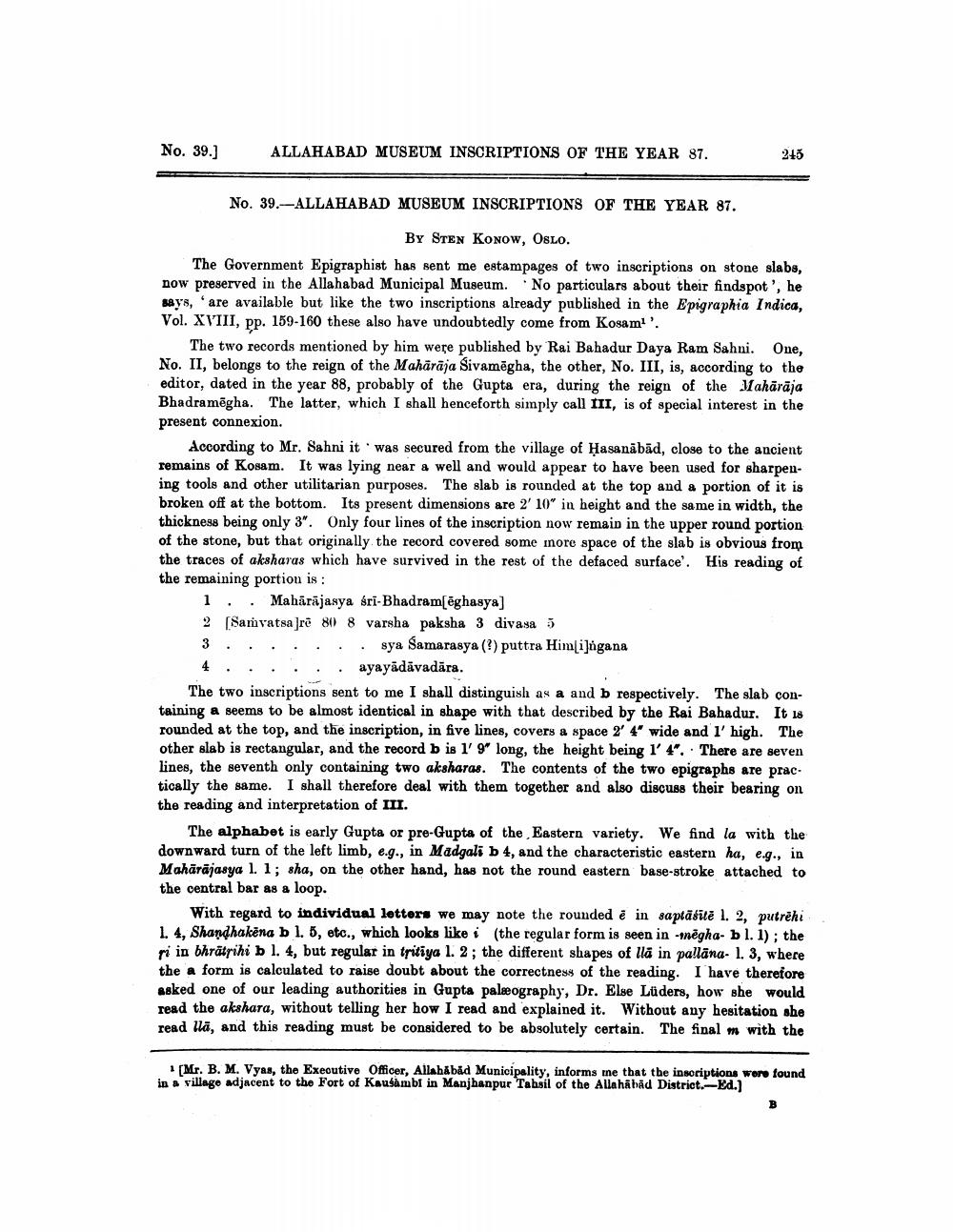________________
No. 39.]
ALLAHABAD MUSEUM INSCRIPTIONS OF THE YEAR 87.
215
No. 39.-ALLAHABAD MUSEUM INSCRIPTIONS OF THE YEAR 87.
BY STEN KONOW, Oslo. The Government Epigraphist has sent me estampages of two inscriptions on stone slabs, now preserved in the Allahabad Municipal Museum. No particulars about their findspot', he says, are available but like the two inscriptions already published in the Epigraphia Indica, Vol. XVIII, pp. 159-160 these also have undoubtedly come from Kosam!!
The two records mentioned by him were published by Rai Bahadur Daya Ram Sahni. One, No. II, belongs to the reign of the Mahārāja Sivamēgha, the other, No. III, is, according to the editor, dated in the year 88, probably of the Gupta era, during the reign of the Jahārāja Bhadramēgha. The latter, which I shall henceforth simply call III, is of special interest in the present connexion.
According to Mr. Sahni it was secured from the village of Hasanābād, close to the ancient remains of Kosam. It was lying near a well and would appear to have been used for sharpening tools and other utilitarian purposes. The slab is rounded at the top and a portion of it is broken off at the bottom. Its present dimensions are 2' 10" in height and the same in width, the thickness being only 3". Only four lines of the inscription now remain in the upper round portion of the stone, but that originally the record covered some more space of the slab is obvious from the traces of aksharas which have survived in the rest of the defaced surface'. His reading of the remaining portion is :
1. Mahārājasya Sri-Bhadram[ēghasya] 2 [Saruvatsa ]re 80 8 varsha paksha 3 divana 5 3 . . . . . . . Sya Samarasya (?) puttra Him[i]ågana
4 . . . . . . ayayadavadāra.
The two inscriptions sent to me I shall distinguish as a and b respectively. The slab containing a seems to be almost identical in shape with that described by the Rai Bahadur. It 18 rounded at the top, and the inscription, in five lines, covers a space 2' 4' wide and l'high. The other slab is rectangular, and the record b is 1' 9" long, the height being 1' 4". There are seven lines, the seventh only containing two aksharas. The contents of the two epigraphs are prac. tically the same. I shall therefore deal with them together and also discuss their bearing on the reading and interpretation of III.
The alphabet is early Gupta or pre-Gupta of the Eastern variety. We find la with the downward turn of the left limb, e.g., in Madgali b 4, and the characteristic eastern ha, e.g., in Mahārājasya 1. 1; sha, on the other hand, has not the round eastern base-stroke attached to the central bar as a loop.
With regard to individual letters we may note the rounded è in saptāsītē l. 2, putrēhi 1. 4, Shandhakena b 1. 5, etc., which looks like i (the regular form is seen in -megha- b 1.1); the ri in bhrätrihi bl. 4, but regular in tritiya 1. 2; the different shapes of llä in pallāna. 1. 3, where the a form is calculated to raise doubt about the correctness of the reading. I have therefore seked one of our leading authorities in Gupta palæography, Dr. Else Lüders, how she would read the akshara, without telling her how I read and explained it. Without any hesitation she read lla, and this reading must be considered to be absolutely certain. The final m with the
1 (Mr. B. M. Vyas, the Executive Officer, Allahabad Municipality, informs me that the insoriptions were found in a village adjacent to the Fort of Kausambl in Manjhanpur Tabsil of the Allahabad District.Ed.)




